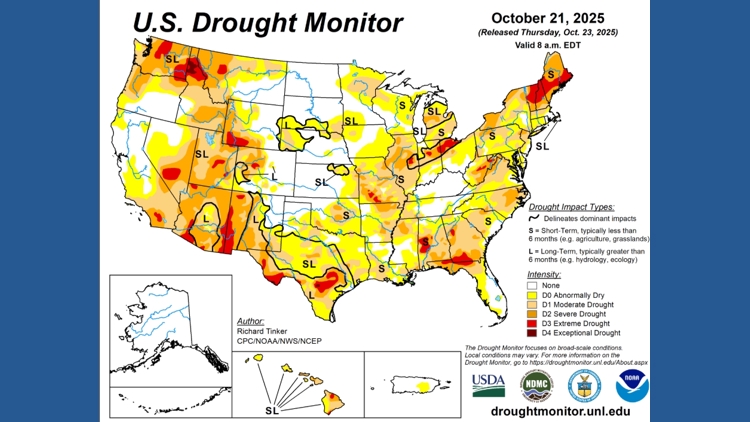World
Drought Conditions Shift Across the U.S. Amid Unusual Rainfall

Major shifts in drought conditions have been observed across the United States this week, marked by some regions experiencing rare early-season rainfall while others are sliding deeper into dryness. According to Richard Tinker, a meteorologist and drought expert with the National Weather Service and the National Oceanic and Atmospheric Administration, the latest drought map reflects significant changes compared to recent weeks.
Unusual Early Rainfall Offers Hope
Much of the western United States, including states like California and Nevada, has reported an increase in precipitation as the fall season approaches. Tinker described the rainfall as “unusual” for this time of year, leading to improvements in drought conditions across extensive areas. “Typically, this time of year we try to be cautious,” Tinker noted. “We don’t want to give the impression that if it’s wet early, everything’s fine.”
He emphasized that while the early rain is a positive development, the situation remains precarious, especially if drier conditions return in the coming months. “This week features actually quite a bit of change from last week,” Tinker added. The recent precipitation has provided a glimmer of hope after months of widespread drought across the region.
Dry Conditions Worsen in the South and East
In contrast to improvements out West, parts of the southern United States and along the Atlantic Coast have seen deteriorating conditions. Areas in Louisiana, Texas, Georgia, and South Carolina have experienced increased drought intensity. Tinker explained, “It’s been very much a case of the haves and have-nots. Some places got good rain, and some places didn’t.”
The worsening drought in the South has been fueled by dry air, elevated temperatures, and wind over the past month or two, leading to a quicker decline in moisture levels than typically seen in October.
Improvements in the Ohio Valley
Conversely, the Ohio Valley has benefited from substantial rainfall, particularly in regions such as southern Michigan, Ohio, Kentucky, Illinois, Missouri, and parts of Mississippi. Tinker noted that repeated storms in these areas have contributed to significant improvements in drought conditions. “These areas have seen quite a bit of improvement — not just this week, but over the last few weeks,” he said.
The recent rainfall has not only alleviated drought effects but also highlighted the variability of weather patterns currently affecting the nation.
Wider Implications of Drought
Tinker, who has focused on drought monitoring since 2000, underscored that the consequences of prolonged dryness extend beyond agriculture. “Drought is a creeping weather phenomenon — it sneaks up on you,” he explained. Its impacts can affect water supply, transportation, and even recreation. For instance, low stream flows and reduced lake levels can disrupt barge traffic and limit access to drinking water.
“There’s a million little things that are affected by drought,” Tinker added. “Some can impact the economy significantly, and others affect people’s well-being.”
As of now, the national drought monitor indicates that nearly three-quarters of the United States is experiencing some level of dryness or drought, with over 20 percent of these areas classified under the most severe drought categories, ranging from severe to exceptional.
In summary, while some regions are witnessing positive shifts in moisture levels, others are facing deepening drought conditions, reflecting the complex and often unpredictable nature of weather patterns across the country.
-

 Science2 months ago
Science2 months agoInventor Achieves Breakthrough with 2 Billion FPS Laser Video
-

 Health2 months ago
Health2 months agoCommunity Unites for 7th Annual Into the Light Walk for Mental Health
-

 Top Stories2 months ago
Top Stories2 months agoCharlie Sheen’s New Romance: ‘Glowing’ with Younger Partner
-

 Entertainment2 months ago
Entertainment2 months agoDua Lipa Aces GCSE Spanish, Sparks Super Bowl Buzz with Fans
-

 Health2 months ago
Health2 months agoCurium Group, PeptiDream, and PDRadiopharma Launch Key Cancer Trial
-

 World2 months ago
World2 months agoIsrael Reopens Rafah Crossing After Hostage Remains Returned
-

 Top Stories2 months ago
Top Stories2 months agoFormer Mozilla CMO Launches AI-Driven Cannabis Cocktail Brand Fast
-

 Entertainment2 months ago
Entertainment2 months agoMother Fights to Reunite with Children After Kidnapping in New Drama
-

 World2 months ago
World2 months agoR&B Icon D’Angelo Dies at 51, Leaving Lasting Legacy
-

 Business2 months ago
Business2 months agoTyler Technologies Set to Reveal Q3 Earnings on October 22
-

 Health2 months ago
Health2 months agoYouTube Launches New Mental Health Tools for Teen Users
-

 Health2 months ago
Health2 months agoNorth Carolina’s Biotech Boom: Billions in New Investments








